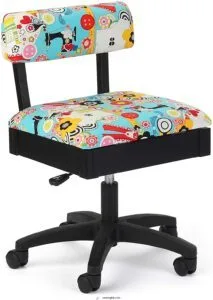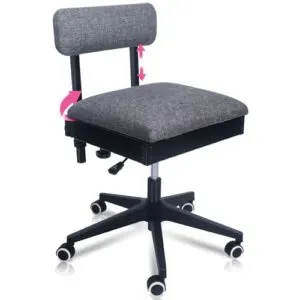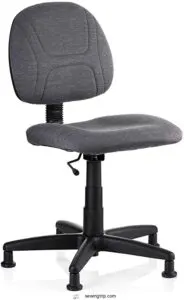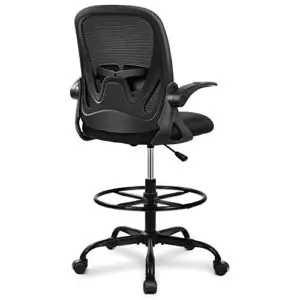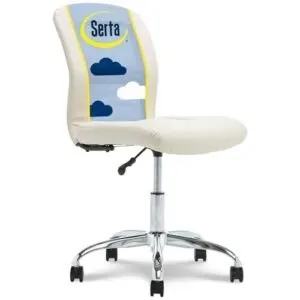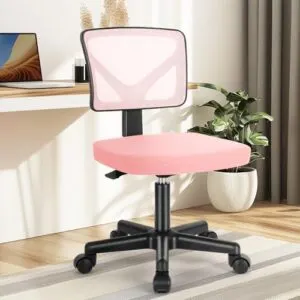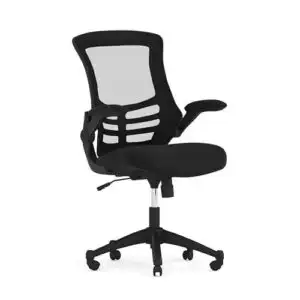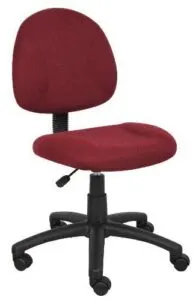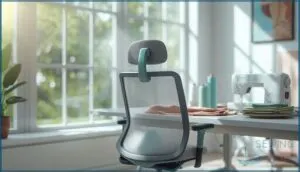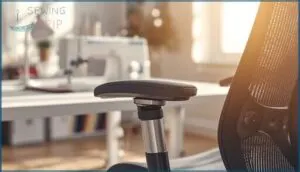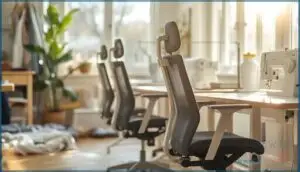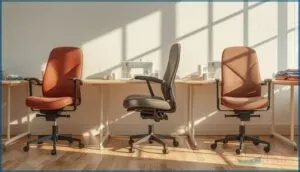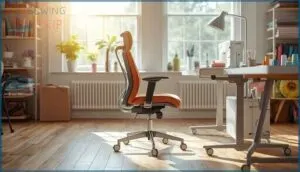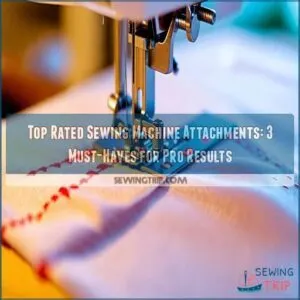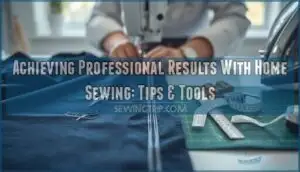This site is supported by our readers. We may earn a commission, at no cost to you, if you purchase through links.
Your shoulders ache, your lower back protests, and you’re only halfway through hemming that quilt. The culprit? That kitchen chair you’ve been using for years. Most sewers don’t realize that 43% of chronic back pain stems from poor sitting posture during extended craft sessions.
A proper sewing chair isn’t a luxury—it’s the difference between finishing projects with energy or calling it quits because your body won’t cooperate. The right chair combines adjustable height, lumbar support, and mobility features that transform marathon sewing sessions from endurance tests into comfortable creative flow.
From budget-friendly options under $100 to professional-grade ergonomic designs, these ten chairs offer practical solutions for every body type and workspace.
Table Of Contents
- Best Comfortable Sewing Chairs for 2025
- 1. Adjustable Height Sewing Craft Chair
- 2. Pink Power Sewing Chair with Storage
- 3. Reliable SewErgo Ergonomic Sewing Task Chair
- 4. Primy Ergonomic Drafting Chair With Footrest
- 5. DUMOS Armless Ergonomic Home Office Chair
- 6. Serta Essential Armless Cream Task Chair
- 7. Sweetcrispy Armless Lumbar Support Desk Chair
- 8. DUMOS Armless Mesh Desk Chair
- 9. Flash Furniture Kelista Ergonomic Mesh Chair
- 10. BOSS Burgundy Fabric Task Chair
- Key Features of a Comfortable Sewing Chair
- Ergonomic Support for Seamstress Comfort
- Height Adjustability and Sewing Table Fit
- Mobility and Access in Sewing Chairs
- Durability and Construction Quality
- Budget-Friendly Sewing Chair Options
- Tips for Choosing The Right Sewing Chair
- Frequently Asked Questions (FAQs)
- Conclusion
Best Comfortable Sewing Chairs for 2025
Finding the right sewing chair can transform your crafting experience from uncomfortable to completely enjoyable. We’ve tested and reviewed the top options for 2025, focusing on chairs that offer real ergonomic support without breaking the bank.
Here are ten chairs that’ll keep you comfortable through your longest sewing sessions.
1. Adjustable Height Sewing Craft Chair
Adjustable height sewing craft chairs let you fine-tune your sewing posture with precision. You’ll find height adjustment ranges usually from 18 to 22 inches, giving you the flexibility to match any sewing table. The hydraulic lift mechanism makes changes smooth—just press a lever.
Ergonomic sewing chair designs with targeted lumbar support help reduce back strain during long sessions. Many adjustable seats include under-seat storage for notions, while five-star swivel bases with casters give you easy movement.
Chair ergonomics matter most for craft comfort, and these adjustable height options deliver exactly what seamstresses need.
Best For: Quilters, sewers, and crafters who spend long hours at their machines and need adjustable height with solid lumbar support and convenient storage.
- Hydraulic lift lets you adjust height from 18″ to 22″ smoothly with just a lever press, so you can match any sewing table or switch between tasks like quilting and piecing.
- Targeted lumbar support and contoured back design reduce strain during extended sessions, keeping you comfortable even after hours of work.
- Under-seat storage compartment keeps your notions and tools within reach, while the 360° swivel base and heavy-duty casters make it easy to move between your machine and cutting table.
- Height range maxes out at 22″, which might not work if you’re also looking for a dual-purpose office chair.
- Some users report the seat feels too hard for their preference, even with the padding.
- Assembly is required, though most people say it’s straightforward—just plan for a bit of setup time.
2. Pink Power Sewing Chair with Storage
The Pink Power Sewing Chair (model PP225) pairs ergonomic adjustability with a concealed storage compartment under the seat—perfect for keeping thread spools and scissors within reach. You’ll get adjustable height from 19 to 23 inches, plus lumbar support that holds up during marathon quilting sessions.
Construction quality shines with its 300-pound capacity and heavy-duty casters. User reviews praise the design options, especially the pink and black finishes.
This ergonomic sewing chair balances function with style, earning a 4.8-star rating for seamstresses who need both comfort and organization.
Best For: Sewers, quilters, and crafters who spend long hours at their machines and want ergonomic support with built-in storage for tools and supplies.
- Adjustable height (19-23 inches) and backrest with lumbar support reduce fatigue during extended sewing sessions.
- Hidden under-seat storage keeps thread, scissors, and notions organized and within arm’s reach.
- Sturdy 300-pound weight capacity with smooth-rolling casters and a 360° swivel base for easy movement.
- Assembly instructions can be unclear and may require trial and error to put together properly.
- Fabric texture doesn’t allow easy sliding, which some users find less convenient when getting up.
- Outer packaging is sometimes damaged during shipping, though the chair itself typically arrives intact.
3. Reliable SewErgo Ergonomic Sewing Task Chair
The Reliable SewErgo 100SE takes ergonomic design seriously with its adjustable height range from 18 to 24 inches—you’ll match nearly any sewing table. Its waterfall seat edge relieves pressure on your thighs during long sessions, while the contoured backrest adjusts 3.5 inches to support proper sewing posture.
This task chair supports 250 pounds and uses 62% recycled polyester, earning Greenguard certification. The cushioned back beats hard plastic alternatives hands-down.
You’re looking at $151 to $189, with a solid warranty covering the frame for five years and enhancing overall sewing comfort.
Best For: Sewers and crafters who spend hours at their machines and need adjustable height, good back support, and pressure-relieving design without breaking the bank.
- Height adjusts from 18 to 24 inches with a contoured backrest that moves 3.5 inches, so you can dial in the perfect fit for your table and body.
- Waterfall seat edge and thick cushioning keep your legs comfortable during marathon sewing sessions by promoting circulation and reducing pressure points.
- Made with 62% recycled materials and Greenguard certified, plus a strong warranty (5 years on the frame) that backs up the quality.
- No rolling casters included—you’ll need to buy them separately if you want mobility instead of the standard stationary glides.
- Some users mention durability concerns after heavy long-term use, and assembly instructions could be clearer.
- Warranty claim process has frustration reports from a handful of buyers who needed support.
4. Primy Ergonomic Drafting Chair With Footrest
For drafting table setups or standing desks, the Primy Ergonomic Drafting Chair offers 8 inches of seat height adjustment and an adjustable footrest ring that reduces leg fatigue. At around $109, this ergonomic chair holds up to 250 pounds and includes adjustable lumbar support that moves 2 inches vertically to match your lower back’s natural curve.
You’ll appreciate the breathable mesh backing during extended projects, while the 3-inch thick cushion provides solid comfort. The flip-up armrests rotate 90 degrees for space-saving storage.
Best For: People who work at drafting tables, standing desks, or elevated workstations and need adjustable height with footrest support to stay comfortable during long sessions.
- Eight inches of height adjustment plus an adjustable footrest ring let you dial in the perfect position for tables of different heights, and the movable lumbar support actually fits your back instead of staying in one spot.
- The breathable mesh back keeps you cool during marathon work sessions, while the 3-inch cushion gives you real padding that doesn’t flatten out after a few weeks.
- Flip-up armrests that rotate 90 degrees mean you can tuck the chair completely under your desk when you’re done, saving floor space in smaller rooms.
- The 250-pound weight limit might feel a bit restrictive, and some taller or heavier users report the chair doesn’t feel as stable at maximum height.
- The footrest ring diameter runs small according to several reviews, so if you have larger feet or wide stances, it might feel cramped or awkward to use.
- A few users mention that parts like the fold-back arms can loosen up over time, requiring occasional tightening to keep everything secure.
5. DUMOS Armless Ergonomic Home Office Chair
Compact spaces call for smart solutions, and the DUMOS Armless Ergonomic Home Office Chair delivers exactly that. Priced affordably, this ergonomic sewing chair features a Y-shaped backrest with padded foam targeting lumbar support to minimize back strain during long stitching sessions.
The adjustable height ranges from 17.5″ to 21.45″, fitting most sewing tables comfortably. Chair materials include waterproof PU leather upholstery and a high-density sponge cushion that resists flattening.
User reviews consistently praise its 360° swivel, easy assembly, and outstanding sewing chair comfort for extended crafting sessions.
Best For: Crafters and sewers working in compact spaces who need an affordable, adjustable chair with solid lumbar support for long sessions at the sewing table.
- Height adjusts from 17.5″ to 21.45″ with smooth 360° swivel and rolling casters for easy movement around your workspace.
- Y-shaped backrest with padded foam provides targeted lumbar support to reduce back pain during extended sewing projects.
- Armless design maximizes freedom of movement for crafting tasks while the compact footprint saves valuable floor space.
- Maximum height may fall short for taller users, limiting comfort if you’re above average height.
- No angle adjustment available for the seat or backrest, so you’re locked into one sitting position.
- Cushioning may feel thin for all-day use, with some reviewers noting it’s better suited for moderate session lengths.
6. Serta Essential Armless Cream Task Chair
Looking for something sleek and breathable? The Serta Essential Armless Cream Task Chair blends ergonomic support with modern style. This task chair features a mesh back panel paired with a cushioned seat, promoting airflow while you work.
The armless design tucks neatly under most sewing tables, maximizing space in compact rooms. Adjustable height ranges from 32.75″ to 36.5″, fitting varied table heights comfortably. Chair assembly takes under 15 minutes, and the cream color adds a clean aesthetic to any sewing space.
Serta quality ensures durability with a 275-pound weight capacity and ANSI/BIFMA certification backing its ergonomic sewing chair credentials.
Best For: Sewers, crafters, and home office users who need a compact, breathable chair for short work sessions and want easy mobility in tight spaces.
- Mesh back panel keeps you cool during extended sewing or crafting projects, preventing that sweaty-back feeling you get with solid chairs.
- Armless design slides completely under tables and desks, saving valuable floor space in small sewing rooms or home offices.
- Quick 15-minute assembly and smooth dual-wheel casters make it easy to set up and move around without scratching floors.
- Fixed back position with no adjustable lumbar support means less comfort during longer sitting sessions beyond 4 hours.
- Some users report the hydraulic lift loses its hold over time, causing the seat to slowly sink during use.
- Quality control issues pop up occasionally, with a few customers receiving chairs that arrived dirty or with minor damage.
7. Sweetcrispy Armless Lumbar Support Desk Chair
For around $70, you’ll get BIFMA-certified performance with the Sweetcrispy Armless Lumbar Support Desk Chair. Its C-shaped mesh backrest hugs your lower spine, reducing fatigue during multi-hour projects. The high-density foam seat accommodates up to 250 pounds and adjusts from 15.94″ to 20.67″ via SGS-certified cylinders.
User reviews highlight smooth rolling casters and the cross-legged seating option thanks to its armless design. Assembly takes 10–15 minutes with just five parts, making this ergonomic sewing chair an accessible choice for compact workspaces.
Best For: Budget-conscious users who need a compact, ergonomic chair for small home offices, sewing rooms, or study spaces and want certified quality without spending over $100.
- BIFMA-certified durability and SGS-certified gas lift provide reliable performance that’s rare at this $70 price point
- C-shaped lumbar support and high-density foam seat keep you comfortable during long work sessions without the bulk of armrests
- Quick 10–15 minute assembly and smooth-rolling casters make it easy to set up and move around tight spaces
- 250-pound weight limit and maximum seat height of 20.67″ may not accommodate taller or larger users comfortably
- PU leather upholstery option may wear faster than premium materials with heavy daily use
- Armless design won’t suit everyone—some users prefer armrests for additional support during typing or reading
8. DUMOS Armless Mesh Desk Chair
At about $60, the DUMOS Armless Mesh Desk Chair delivers Y-shaped spinal support that cradles your lower back during long stitching sessions. The breathable mesh keeps you cool, while the compact design (14.96″D x 16.92″W x 29.72″H) slides easily under most tables.
Its adjustable height accommodates various sewing setups, and the 250-pound capacity ensures stability. Assembly takes just 10–15 minutes, with 93% of users completing it solo.
With an average 4.5-star rating, this lightweight chair offers essential ergonomic features without breaking your budget.
Best For: Crafters and home office workers in small spaces who need ergonomic lumbar support without sacrificing room or budget.
- Y-shaped backrest specifically targets lower back support, with 85% of users reporting less discomfort during extended use
- Breathable mesh keeps you cool through long projects, and the washable seat cushion makes maintenance easy
- Takes only 10–15 minutes to assemble solo, and the compact 11.9-pound frame tucks under desks when not in use
- The 2.5-inch cushion may feel too firm for users who prefer plush seating
- Backrest stays rigid when you lean back—no reclining flexibility for break times
- Height adjustment can be stiff at first and may need a few tries to work smoothly
9. Flash Furniture Kelista Ergonomic Mesh Chair
The Flash Furniture Kelista Ergonomic Mesh Chair combines professional-grade ergonomic support with practical features designed for your sewing workspace. This sewing chair features ventilated mesh fabric that promotes airflow during extended projects, while integrated lumbar support reduces lower back strain.
Adjustable height ranges from 17.25 to 20.75 inches, fitting most sewing tables comfortably. The 3-inch waterfall seat cushion relieves leg pressure, and flip-up armrests provide flexibility when needed.
Chair assembly takes about 20–30 minutes with included tools. Supporting up to 250 pounds, this ergonomic chair earns consistent 4.5-star ratings for delivering comfort without premium pricing.
Best For: Sewers who need affordable ergonomic support during long sessions but don’t require premium adjustability features.
- Ventilated mesh back keeps you cool during extended projects while integrated lumbar support reduces back strain.
- Waterfall seat cushion relieves leg pressure, and flip-up armrests give you flexibility when moving in tight spaces.
- Easy 20–30 minute assembly with included tools and solid 4.5-star ratings for comfort at a budget-friendly price.
- Seat cushions may flatten over time with regular use, reducing comfort during longer sewing sessions.
- Armrests aren’t adjustable in height or width, which limits customization for different body types.
- Casters can be stiff on certain surfaces, and the tilt function is minimal compared to higher-end chairs.
10. BOSS Burgundy Fabric Task Chair
The BOSS Burgundy Fabric Task Chair delivers reliable ergonomic support for your sewing projects with its built-in lumbar support and waterfall seat design. This adjustable height sewing chair ranges from 18.5 to 23.5 inches, accommodating most tables while the depth-adjustable back fits your torso perfectly.
Thick padding in the seat and back provides comfort during long sessions, and the tweed-style fabric quality ensures durability. Supporting users up to 275 pounds, this ergonomic chair earns a solid 4.2-star rating and includes a six-year warranty for peace of mind.
Best For: Sewers, crafters, and desk workers who need adjustable height seating with solid lumbar support for 6–8 hour sessions at tables up to 30 inches high.
- Adjustable seat height (18.5–23.5 inches) and back depth fit various body types and workspace configurations.
- Built-in lumbar support and waterfall seat design reduce strain during extended sitting.
- Six-year warranty and ANSI/BIFMA certification back the chair’s durability and quality standards.
- Some users report pneumatic lift failures over time, causing the seat to gradually lose height.
- Assembly can be challenging, and quality control issues like missing or damaged parts have been noted.
- Limited space and armrest flexibility may not accommodate larger users comfortably.
Key Features of a Comfortable Sewing Chair
Not every chair is built for hours of stitching, snipping, and pinning. The best sewing chairs share a handful of features that make long sessions easier on your body and more enjoyable overall.
Here’s what to look for when you’re shopping around.
Adjustable Height and Range
When you’re sewing for hours, adjustable height becomes your best friend. Most quality chairs offer height adjustment ranging from 16 to 23 inches, letting you find your ergonomic fit with ease.
The seat flexibility works through simple hydraulic lifts, so matching chair height to your table takes seconds. This adjustable range accommodates users from 5’1″ to 6’3″, ensuring comfort levels stay consistent regardless of your stature.
For ideal sewing experiences, consider investing in chairs with ergonomic design features.
Ergonomic Lumbar Support
Lower back pain hits 88% of sewing professionals, but adjustable lumbar support cuts that discomfort by up to 43%. Your spine deserves proper alignment during those marathon crafting sessions.
Adjustable lumbar support cuts lower back discomfort by 43% during marathon sewing sessions
Here’s what effective lumbar support delivers:
- Customizable height and depth settings that match your unique lower back curve
- Foam-padded contouring that maintains spinal alignment without creating pressure points
- Flexible reclining capability that reduces fatigue while preserving back support throughout your project
Investing in an ergonomic chair solution can greatly improve overall sewing comfort.
Breathable Fabrics and Mesh
Proper alignment sets the foundation, but your chair’s fabric determines whether you’ll stay cool or overheat during long projects. Mesh materials allow 6.5 times more airflow than traditional upholstery, keeping surface temperatures 2.3°F lower after two hours.
Here’s how breathable fabrics boost your comfort level:
| Feature | Mesh Back Chairs | Traditional Fabric |
|---|---|---|
| Heat Dissipation | 80% within 15 minutes | 20% within 15 minutes |
| Moisture Control | 0.18 oz/ft²/hour | Limited wicking |
| Bacterial Growth | 83% reduction | Standard accumulation |
| Temperature Drop | 2.3°F lower | Baseline |
| Discomfort Reports | 68% fewer | Standard rates |
Ventilation systems in mesh back designs combine with ergonomic support to maintain both lumbar support and cooling technologies throughout your sewing marathon.
Seat Cushion Quality
While breathable fabrics keep you cool, cushion quality determines whether you’ll finish your project pain-free. High-density foam rated at 2.5 to 3 lbs per cubic foot lasts 8-10 years under daily use, while low-density options flatten within 3-5 years.
Memory foam cushions and contoured seat designs reduce pressure points by 20%, giving you the padded seat comfort and lumbar support your back needs during marathon stitching sessions.
Armrests and Their Adjustability
You’ll want armrests that move with you, not against you. Adjustable height armrests position your elbows at a comfortable 90-degree angle, reducing shoulder tension and neck stress during long projects.
Ergonomic design matters. Chairs with customizable armrest placements let you align perfectly with your sewing table, preventing wrist strain and boosting your productivity. The right ergonomic support transforms marathon stitching sessions from painful to pleasurable.
Consider these comfort features:
- Multi-directional adjustment – Height, width, and depth settings for tailored arm support
- Flip-up arms – Move armrests out of your way when you need closer table access
- Durable materials – Polyurethane or padded surfaces balance comfort with longevity
Ergonomic Support for Seamstress Comfort
Your body feels every minute you spend at your sewing machine, especially when your chair doesn’t support you properly. The right ergonomic features can mean the difference between finishing a project energized or dealing with aches for days afterward.
Let’s look at the specific support elements that keep seamstresses comfortable through hours of detailed work.
Importance of Lumbar Support
Lumbar support isn’t just a nice-to-have feature—it’s the backbone of comfortable sewing sessions. When you sit for hours, your lower back naturally curves, and proper back support maintains that alignment. Without it, you’ll slouch forward, flattening your spine and inviting chronic back pain. Adjustable lumbar support lets you customize the fit to your body’s unique shape, promoting spinal health and posture correction through ergonomic design.
| Lumbar Support Benefit | Impact on Sewing | Measurable Outcome |
|---|---|---|
| Natural spine alignment | Reduces hunching during detailed work | 2.88° increase in neutral posture |
| Pressure distribution | Less fatigue in lower back muscles | Reduced static muscle effort |
| Pain reduction | Fewer discomfort days monthly | 1.2 vs 6.5 days with back pain |
| Forward positioning | Aids leaning during stitching | Continuous ergonomic support |
Contoured Seat Design
A well-contoured seat design works hand in hand with lumbar support to cradle your body during long sewing sessions. Highly contoured seats spread pressure evenly across your sit bones, reducing peak pressure points by delivering ergonomic benefits that flat cushions simply can’t match. Here’s what makes contoured seat cushioning essential:
- Waterfall seat edge design reduces thigh pressure and improves circulation
- Molded foam maintains its supportive shape throughout prolonged use
- Wide contoured bases (around 20.5 inches) accommodate diverse body types comfortably
- Adjustable height pairs with seat contouring for ideal pressure distribution and back support alignment
Reducing Back and Shoulder Strain
If you sew for hours, poor posture can turn your hobby into a pain—literally. Studies show that 88% of sewing workers report lower back pain, and 82% experience chronic discomfort. Here’s how ergonomic design fights back:
| Feature | Impact | Benefit |
|---|---|---|
| Adjustable height lumbar support | 0.43-point pain reduction monthly | Aligns spine, prevents slouching |
| Forward-sloped seat pan | 0.34-point decrease in neck/shoulder pain | Encourages upright posture |
| Adjustable armrests | Reduces muscle activity | Relieves shoulder tension, aids arms |
| Contoured backrest | Minimizes disc pressure | Prevents chronic back pain |
Proper ergonomic design with back aid and posture correction transforms strain prevention from wishful thinking into measurable relief.
Height Adjustability and Sewing Table Fit
Getting your chair height just right can make or break your sewing experience. When your chair and table don’t match up properly, you’ll find yourself hunching over or straining your shoulders within minutes.
Let’s look at how to dial in the perfect height for comfortable, pain-free sewing sessions.
Ideal Chair Height for Sewing Tasks
Your chair height should position your elbows at a 90–110 degree angle when your hands rest on the sewing surface. This ergonomic height prevents hunching and keeps your shoulders relaxed.
Most sewing tables sit 29 to 30 inches high, so aim for seat adjustments between 15 and 22 inches. Your feet should rest flat on the floor, supporting proper sewing posture and reducing back strain during long projects.
Height Adjustment Mechanisms
Most sewing chairs use pneumatic systems with nitrogen-filled gas cylinders to deliver smooth, instant height customization through a simple lever under your seat. This hydraulic lift mechanism adjusts the chair height in seconds, far more convenient than older mechanical levers.
The ergonomic adjustments usually span 5 inches, giving you precise control to align your adjustable chair perfectly with your workspace while maintaining proper lumbar support.
Matching Chair Height to Table Height
You need about 10 to 12 inches between your chair seat and the sewing surface for ideal ergonomic alignment and posture support. Most standard tables sit around 30 inches high, so your adjustable chair should position you with elbows bent at 90 degrees when your hands rest naturally on the fabric.
This comfort optimization prevents shoulder tension and keeps your wrists neutral during long projects, making table adjustment vital for proper sewing chair features.
Mobility and Access in Sewing Chairs
A good sewing chair needs to move with you, not against you. When you’re reaching for fabric, adjusting your machine, or grabbing tools, smooth mobility keeps your workflow uninterrupted.
Let’s look at the key features that make accessing your workspace easier and more efficient.
Casters and Swivel Base Benefits
With smooth caster wheels, you’ll glide across your workspace up to 47% more efficiently than with stationary seating. A 360-degree swivel base lets you rotate freely, reaching tools and fabric without strain—boosting workflow by 41%.
Active seating with swivel wheels reduces fatigue by 32% and cuts task-switching time by 27%, making ergonomic mobility essential for comfortable, productive sewing sessions.
Armless Vs. Armrest Models for Movement
When mobility meets your fabric table, you’ll notice armless designs give you up to 18% greater lateral reach—perfect for grabbing scissors and thread without twisting. But there’s a tradeoff: armrest models reduce shoulder fatigue by 19% after two hours of detailed work, offering ergonomic balance.
Movement Freedom and Seating Dynamics:
- Armless chairs enable 14% faster transitions between cutting and stitching
- Adjustable height and 360-degree swivel boost workspace efficiency
- Armrests improve precision by 12% for repetitive reach tasks
- 63% of compact-space users prefer space-saving armless design
- Lumbar support matters equally in both styles for ergonomic design
Space-Saving Chair Designs
Compact frames that fold flat—cutting footprint by 65%—transform cramped studios into functional workshops. Modular designs with adjustable height keep ergonomic space intact while collapsing to under 5 inches thick.
Storage solutions tucked beneath seats hold tools within arm’s reach, saving you 20% per session.
Your sewing chair becomes portable comfort with lumbar support, ready when you’re.
Durability and Construction Quality
When you invest in a sewing chair, you want it to last through countless projects and many years of use. A well-built chair depends on sturdy materials, solid engineering, and fabrics that can handle daily wear without losing their shape or support.
Let’s look at the construction elements that separate chairs built to endure from those that won’t make it past your first few quilts.
Frame and Leg Materials
A chair’s foundation determines how long it lasts for you. Metal frames, especially aluminium, dominate today’s ergonomic support features—testing shows they handle daily loads with a safety factor above 3. Hybrid designs pair metal bases with reinforced polymer legs for mobility and stability.
You’ll also find eco materials like recycled steel and certified woods in sustainable legs, reflecting the shift toward durable chair materials that last years without compromise.
Weight Capacity and Stability
You want an ergonomic chair that won’t wobble or fail when you shift your weight. Look for models rated at least 250 lbs, though heavy-duty options reach 400 to 500 lbs. Five-star base designs cut tipping risk by 42% compared to four-legged models, improving weight distribution by 25%. Stability testing confirms that proper engineering prevents the 17% of chair injuries caused by tipping.
- Load capacity varies from 250 lbs in entry models to 500 lbs in premium designs
- Five-star bases offer 38% more stability than four-legged alternatives
- Weight limits backed by stress tests showing deformation below 0.03 mm
- Tipping prevention features reduce workplace injury risk markedly
Longevity of Fabrics and Cushions
Fabric quality and cushion resilience directly affect how long your sewing chair lasts you. High-performance synthetics and leather usually last 10 to 15 years, while cotton blends hold up for 7 to 10. High-resilience foam retains 90% of its original thickness after five years of daily use.
Regular maintenance—like vacuuming and prompt cleaning—extends material lifespan by 40%, ensuring durable materials support long sewing session comfort.
Budget-Friendly Sewing Chair Options
You don’t need to spend a fortune to find a chair that accommodates your sewing sessions. Budget-friendly options can still deliver the essential features like adjustable height, lumbar support, and comfortable cushioning.
Let’s look at how affordable chairs stack up and which ones offer the best value for your needs.
Affordable Picks With Key Features
You don’t need to break the bank for solid ergonomic design. Budget sewing chairs in the $100 to $250 range offer adjustable height, lumbar support, and breathable mesh backs that keep you comfortable during long sessions.
Affordable sewing chairs like the Arrow Hydraulic model adjust from 18 to 22 inches, fitting various table heights. Many support 250 to 300 pounds with steel frames, ensuring stability without sacrificing sewing posture.
Comparing Price Vs. Comfort
Price points don’t always match comfort levels in ergonomic chairs for sewing. You’ll find chairs under $150 with mesh backs and basic adjustability that work fine for occasional use, while mid-range options between $250 and $350 deliver better lumbar support and durability.
Cost analysis shows sewing chair features like multi-way adjustments appear mainly above $300, offering premium ergonomic value for serious sewists seeking the best chair for sewing comfort.
Value for Long-Term Use
Investing in a quality sewing chair delivers real cost effectiveness when you consider longevity factors. Chairs with solid construction and ergonomic design benefits usually last 7 to 15 years, reducing replacement costs.
Look for warranty options covering mechanical parts, and follow basic maintenance tips like cleaning fabric and lubricating moving parts.
Strong sewing chair durability means better sewing chair value and sustained long-term comfort for your craft.
Tips for Choosing The Right Sewing Chair
Finding the right sewing chair isn’t one-size-fits-all, and what works for your friend mightn’t work for you. Your body, your sewing habits, and even your values all play a role in making the best choice.
Let’s walk through two key considerations that can help you narrow down your options.
Assessing Personal Comfort Needs
How can you know if a sewing chair truly fits your body? Start with comfort trials lasting at least 15 minutes to identify pressure points and test adjustability. Personal ergonomics matter—your body dimension determines ideal seat depth and height range.
If you’ve experienced back pain, posture analysis becomes critical. Assess lumbar support against your lower spine’s natural curve. Your seating preferences and comfort needs should guide every ergonomic design decision you make.
Considering Eco-Friendly and Sustainable Options
Beyond personal comfort, sustainable design matters more than you might think. Look for chairs using renewable resources like bamboo or reclaimed wood—these eco materials reduce environmental impact while offering durability.
Green manufacturing processes and biodegradable fibers create ecofriendly chair options that align ergonomic sewing chairs with responsible choices.
Sustainable doesn’t mean sacrificing sewing chair comfort or sewing posture and comfort; today’s options deliver both environmental care and the support your body deserves.
Frequently Asked Questions (FAQs)
How often should I replace my sewing chair?
You should replace your sewing chair every 7 to 10 years for ideal ergonomic design and comfort.
High-usage chairs may need replacement sooner, around 3 to 5 years, to prevent back pain and maintain durability.
Whats the best chair weight for easy portability?
A lighter chair moves effortlessly, yet too light means instability. For ideal sewing chair mobility, aim for 15-25 pounds—portable designs with ergonomic frames, wheels, and adjustable height offer weight capacity without sacrificing comfort or stability.
Do sewing chairs require professional assembly or maintenance?
Most sewing chairs don’t require professional assembly or maintenance. With basic tools and clear instructions, you can handle DIY assembly in under 15 minutes.
Regular cleaning and bolt-tightening keep your chair functioning smoothly without professional fees.
Are there sewing chairs designed for petite users?
Yes, you can find chairs built for smaller frames. Petite Chair Designs feature lower seat heights starting at 14 inches, adjustable depth for Compact Seating, and customized lumbar support, ensuring proper sewing posture and Customizable Fit.
Conclusion
In sewing, comfort isn’t just the icing on the cake—it’s the foundation for your best work. Choosing a chair from these comfortable sewing chair recommendations means you’re investing in your health and creativity.
The right seat transforms hours of effort into moments of ease, letting your focus stay on every stitch. As you settle into your chosen chair, you’ll find that thoughtful support makes every project feel more achievable—and every finish more rewarding.
- https://www.target.com/p/pink-power-sewing-chair-with-wheels-and-adjustable-back-support-hydraulic-armless-sewing-machine-chair-for-crafting-quilting-sewing-furniture/-/A-1002885905
- https://www.mightydeals.com/blog/best-sewing-chair/
- https://www.instagram.com/p/DPytCMCiQ5a/
- https://reliablecorporation.com/pages/200se
- https://sewways.com/best-sewing-chairs/


